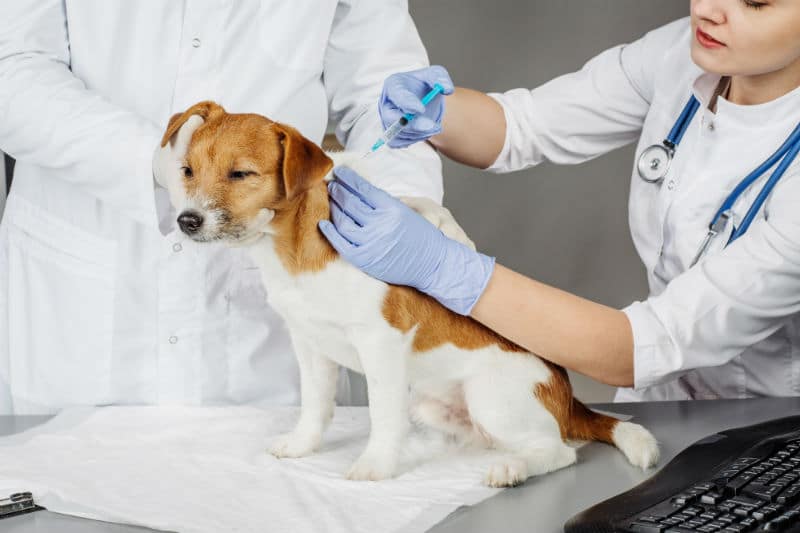What is fine needle aspiration in animals? - A needle in the haystack of animal diagnostics
Diagnosing diseases in animals can often be challenging. One of the helpful procedures for identifying tissue changes and diseases is fine needle aspiration. But what is fine needle aspiration in animals? In this article, we take a detailed look at this innovative method and how it helps veterinarians make reliable diagnoses.

What is fine needle aspiration in animals and how does it work?
Fine needle aspiration is a minimally invasive technique that uses a very thin needle to remove cells or fluid from suspicious areas of tissue. The samples obtained in this way are then examined microscopically to make a diagnosis. This method is often used in animals to examine changes in organs, lymph nodes or tumors.
Advantages of fine needle aspiration
- Minimal pain and stress for the animal
- Fast and cost-effective sampling
- Low risk of complications
- No anesthesia required
Areas of application of fine needle aspiration in animals
- Tumor diagnostics : Fine needle aspiration makes it possible to identify tumor cells and differentiate between benign and malignant changes.
- Examining organ changes : Fine needle aspiration can be used to examine changes in organs such as the liver, spleen or kidney.
- Lymph node examination : The method can be used to detect lymph node changes and possible infections or metastases.
Frequently Asked Questions - FAQs:
What is fine needle aspiration in animals and why is it important?
Fine needle aspiration is a minimally invasive method of obtaining cells or fluids from suspicious areas of tissue in animals. It enables veterinarians to make reliable diagnoses and is particularly important when examining tumors, organ changes and lymph nodes.
Is fine needle aspiration painful for the animal?
Fine needle aspiration typically causes minimal pain and stress to the animal because a very thin needle is used and no anesthesia is required.
How accurate is fine needle aspiration in diagnosing diseases?
The accuracy of fine needle aspiration depends on the quality of the sample taken and the experience of the veterinarian. In general, the method can provide reliable diagnoses, especially when used in combination with other diagnostic procedures.
Can fine needle aspiration be used on all animals?
Fine needle aspiration is a versatile procedure that can be used on a variety of animal species, including dogs, cats, horses, rodents and birds. The suitability for each animal depends on the type of tissue change to be examined and the animal's state of health.
Are there any risks or side effects with fine needle aspiration?
The risks of fine needle aspiration are generally low because it is a minimally invasive procedure. Possible side effects may include pain, swelling, or infection at the injection site. However, these are rare and usually easy to treat.
Alternatives and additions to fine needle aspiration
Although fine needle aspiration in animals is a useful procedure for diagnosing tissue changes and diseases, there are also alternative or complementary methods that can be used depending on the situation.
- Biopsy : A biopsy is another technique for taking tissue samples. However, unlike fine-needle aspiration, a biopsy takes larger samples, allowing for a more detailed examination. A biopsy may be necessary if fine-needle aspiration does not provide a clear diagnosis or if a larger sample is required.
- Imaging techniques : Imaging techniques such as x-rays, ultrasound, computed tomography (CT) or magnetic resonance imaging (MRI) can be used to visualize organs and tissues. These methods can be used in addition to fine needle aspiration to specify the location of the changes to be examined and to support the diagnosis.
- Laboratory tests : Blood, urine or stool tests can provide additional information about the animal's health and help rule out or confirm certain diseases.
Collaboration between veterinarian and pet owner
The successful diagnosis and treatment of illnesses in animals requires close cooperation between veterinarian and animal owner. Fine needle aspiration is just one of many diagnostic methods available. Pet owners should consult a veterinarian immediately if they suspect their pet is ill and disclose all relevant information, such as symptoms or behavioral changes.
The veterinarian will decide, based on the symptoms and clinical examination, which diagnostic procedures are most appropriate to make an accurate diagnosis. Fine needle aspiration may be one of the methods considered depending on the type of disease suspected and the animal's condition.
Final thoughts
Fine needle aspiration in animals is a valuable diagnostic method that allows veterinarians to quickly and efficiently obtain samples of suspicious tissue and make a diagnosis. However, it is important that pet owners and veterinarians work together to develop the best diagnostic and therapeutic strategy for the affected animal.
Fine needle aspiration is just one of many techniques used in veterinary medicine, and it is critical that veterinarians and pet owners communicate openly to achieve the best possible outcome for the animal. Together, they can help maintain and improve the health and well-being of our animal companions.
Fine needle aspiration is a valuable method in veterinary medicine to diagnose tissue changes and diseases in animals. The minimally invasive technique causes little pain and stress to the animal, while allowing veterinarians to take samples quickly and cost-effectively. The areas of application of fine needle aspiration range from tumor diagnostics to the examination of organ changes to lymph node examination.
Overall, fine needle aspiration helps to enable early and accurate diagnosis of diseases in animals, which in turn enables targeted and effective treatment. The method is an important part of modern veterinary medicine and will certainly continue to play a crucial role in the diagnosis and treatment of animal diseases.
If you would like to have a fine needle aspiration carried out, then contact our expert, veterinarian Anna Daum.

Pingback: Pancreatitis in dogs - Veterinarian Karlsruhe - Small Animal Center Arndt
Pingback: Cancer in dogs - Veterinarian Karlsruhe - Small Animal Center Arndt